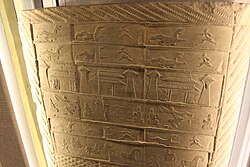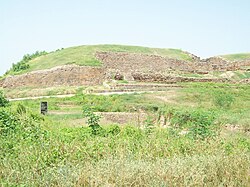Fortification
Fortifications are military constructions and buildings designed for defense during war. People have constructed defensive works for many thousands of years, but the designs have become more and more complex. The term fortification comes from the Latin words fortis ("strong") and facere ("to make").
Many military installations are known as forts, although they are not always fortified. Larger forts may class as fortresses, smaller ones formerly often bore the name of fortalices. Some are castles. The word fortification can also mean the practice of improving an area's defense with defensive works. City walls are fortifications but not necessarily called fortresses.
The last great system of fortification to be built was the Atlantic Wall.
Fortification Media
Castillo San Felipe del Morro, Puerto Rico. The fortress and walled city of Old San Juan are a UNESCO World Heritage Site.
Maiden Castle in 1935. The Iron Age hillfort was first built in 600 BC.
Han dynasty tomb brick showing gate towers
Remains of a fortified village, Borġ in-Nadur, Malta. Borġ in-Nadur is a notable example of Bronze Age fortifications.
Reconstructed walls of Bibracte, a Gaulish oppidum, showing the construction technique known as murus gallicus. Oppida were large fortified settlements used during the Iron Age.
An ancient casemate wall at Masada.
An interior view of the Aurelian walls near Porta San Sebastiano
Defensive wall of the ancient city of Dholavira, Gujarat 2600 BCE
Jaisalmer Fort, Rajasthan, India
Rock fort of Sigiriya built by King Kashyapa I of Anuradhapura.
Related pages
Other websites
| Wikimedia Commons has media related to Lua error in Module:Commons_link at line 62: attempt to index field 'wikibase' (a nil value).. |
Gallery
Nakhal Fort, one of the best-preserved forts in Oman
Mehrangarh Fort in Jodhpur (Rajasthan, India)
A restored portion of the Great Wall of China
Fort Frederick Martello Tower in Kingston, Ontario at Royal Military College of Canada
Bare Island Fort in Botany Bay in a suburb called La Perouse, Sydney, Australia
| This article includes text from the public domain 1911 Encyclopaedia Britannica. Please add to the article as needed. |

















